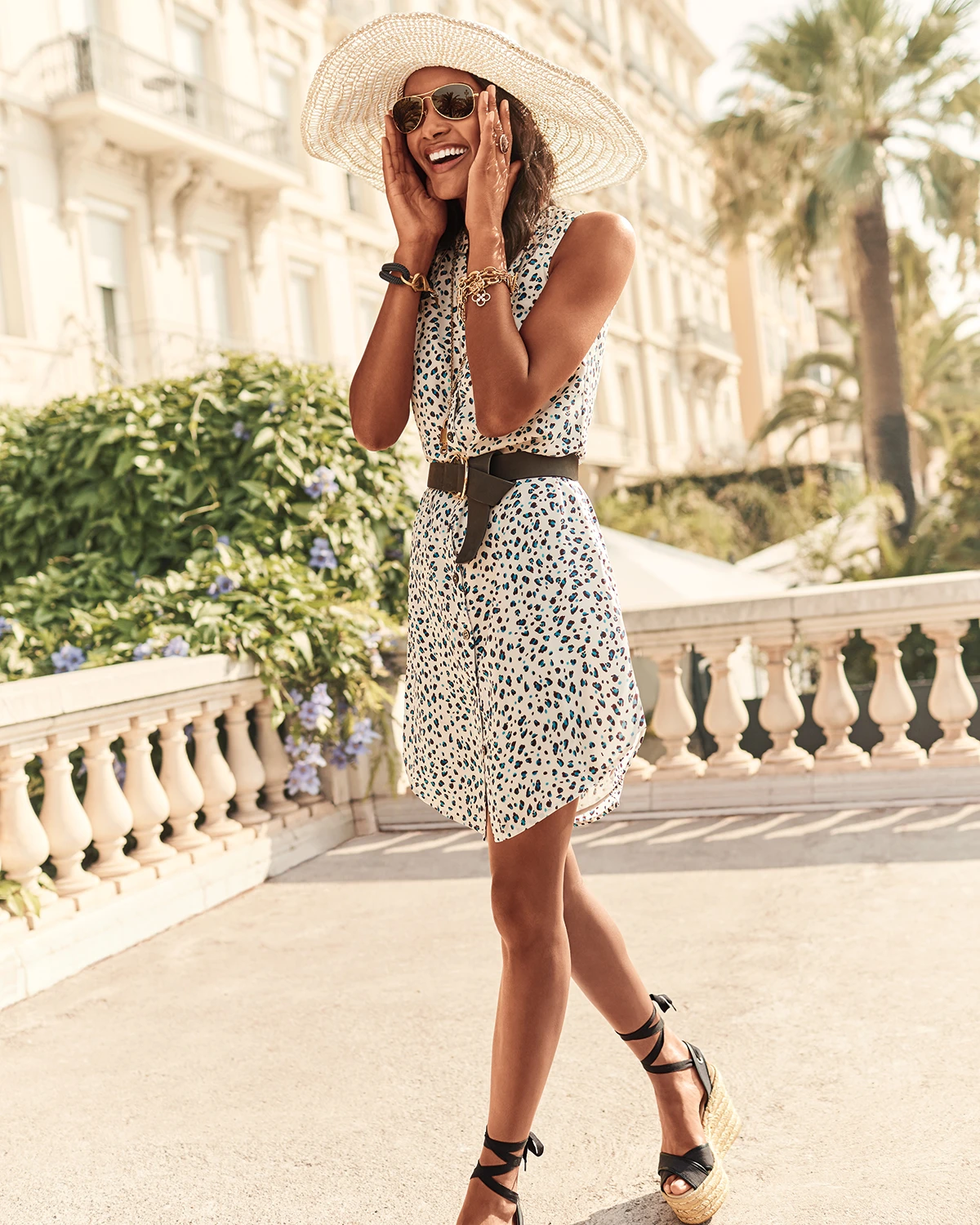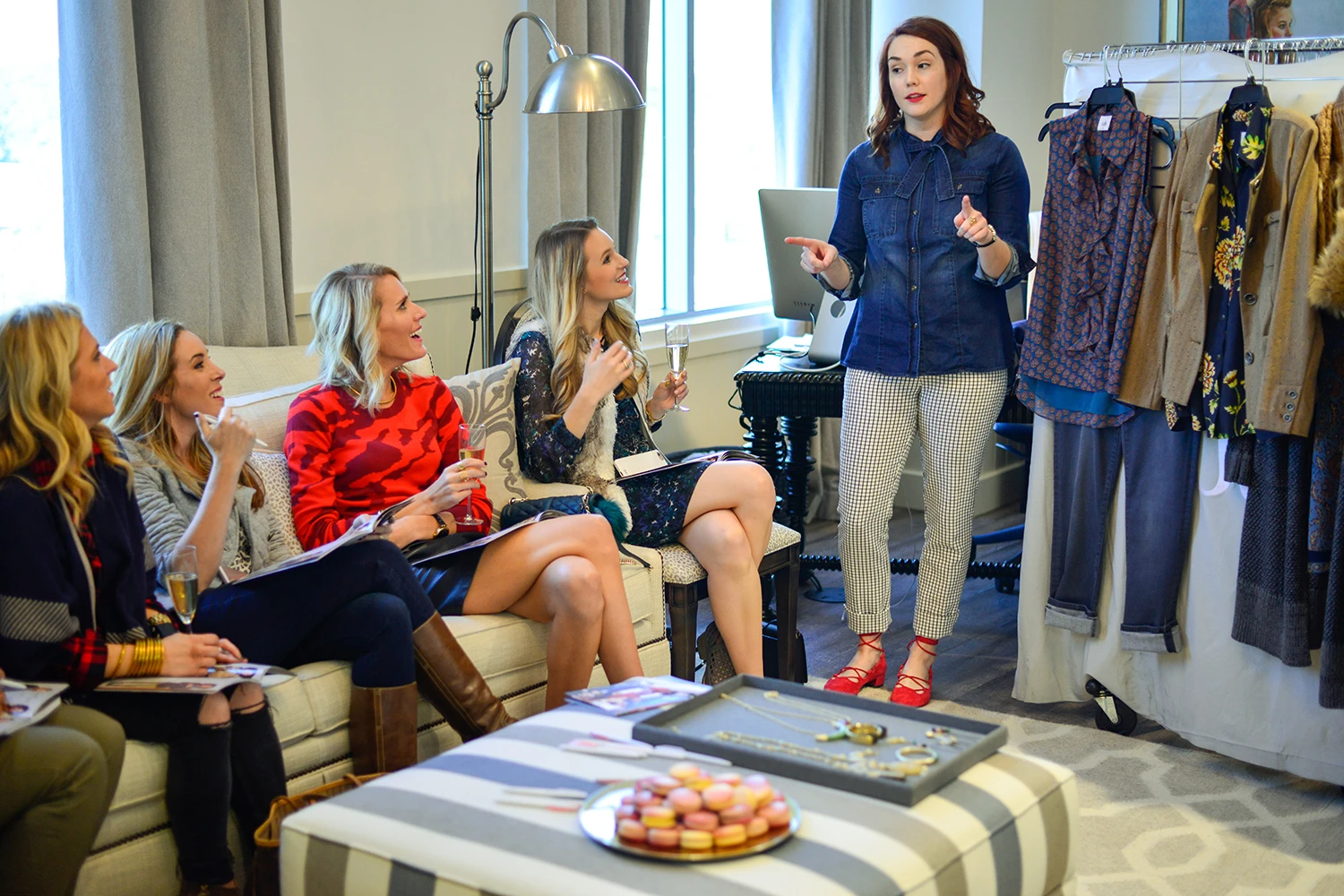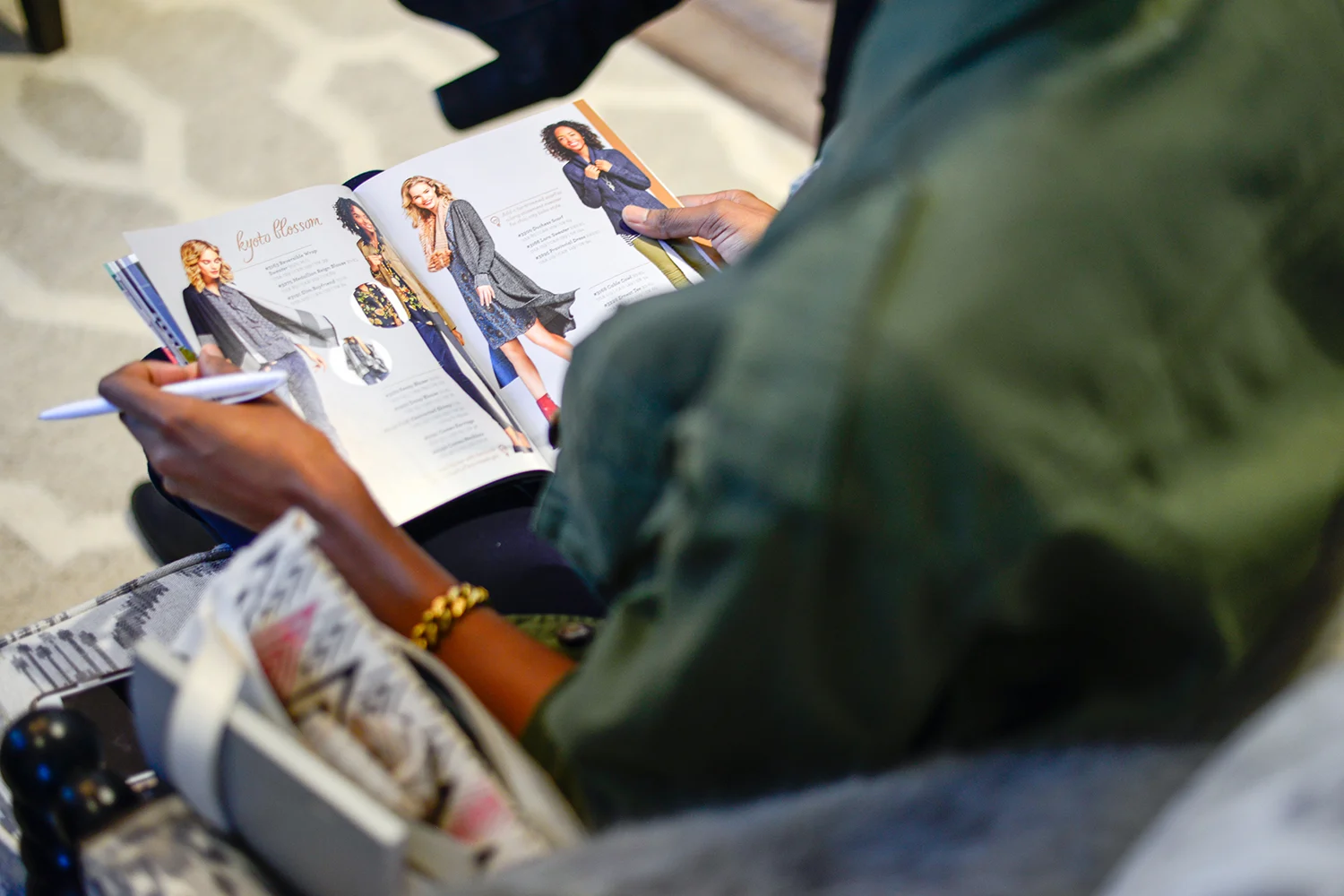On a Wednesday evening in April, I find myself in a well-appointed home in Brookline, a wealthy Boston suburb, sipping wine and eating macarons with a dozen oncologists from the Dana Farber Cancer Institute. Sitting around a coffee table displaying Asian art and colorful books about design, the women—colleagues from the same medical research group, aged between 40 and 60—aren’t talking about their work.
“Oh, you never wear bright colors, but that red looks so good on you,” says one to the other. “I keep buying these pants every season, because they fit so well,” another says. “They are perfect for hiding problem areas on your tummy.”
I’ve joined these women for a trunk show run by Cabi, a social shopping brand that operates in the U.S., the U.K., and Canada. It was founded in 2001 by Kimberly Inskeep, a management consultant looking for a flexible career after her kids were born, and Carol Anderson, a fashion designer in need of a new way to market her products. Together with ten of their friends, they launched Carol Anderson by Invitation (hence, Cabi), a line of clothing that they would sell in their homes in a party-like setting. In the brand’s parlance, they were creating “alternative stores.” Over the last 15 years, the company has steadily grown, and its team of 3,500 salespeople around the world generate more than $250 million in revenue a year.
The concept of selling directly to your friends has been around since the 1950s Tupperware party. But direct selling has been boosted by new trends over the last few years. Thanks to social media, salespeople now have access to bigger networks and operate like other members of the gig economy, earning money in a way that suits their schedule. The sales workforce in this sector is 77% female (compare that to Uber, which overwhelmingly attracts male drivers), and the most successful brands are predominantly for women: Cabi, Worth, Stella & Dot, Beautycounter, Rodan + Fields, and Ellie Kai are blowing up. Globally, direct selling increased by 7.7% in 2015, reaching a new revenue record of $183.7 billion.
Meanwhile, traditional brick-and-mortar retail is in free fall. More than 8,600 physical stores will shut their doors this year, four times the number that closed in 2016, which translates to 147 million square feet of retail space vanishing. In the midst of this brutal retail climate, social selling appears to be offering consumers something that is missing from both the brick-and-mortar experience and e-commerce. I’m at the Cabi party to understand what that is.

Annie Kippe, a Cabi stylist, is at the Brookline trunk show to show this season’s 100-piece collection. Before her presentation begins, everyone gathers informally around the dinner table. The host, who will receive a 50% discount on all her Cabi purchases for holding the event at her house, has prepared a spread of cheese, fruit, tarts, and wine. As we nibble and sip, Kippe explains that she lives in Massachusetts with her husband, a surgeon, and her four kids. In a previous life, she was a retail consultant, but much like Cabi’s founder, she off-ramped when the kids came along. “I kept going to Cabi trunk shows,” Kippe, who is wearing a flowery Cabi two-piece ensemble, tells me. “Then I thought, Being a stylist could be a real career for me.”
She joined Cabi six and a half years ago; now she works there full-time. She travels for trunk shows several nights a week (the frequency depends on her kid’s schedules) and invites clients to her home for personal styling sessions. Cabi treats stylists as independent business owners, rather than employees. Each one must spend $2,500 to pay for the season’s collection. They then go on to make between 25% and 30% commission on each piece sold, yielding an average of $30,000 in yearly earnings. Eighty-six percent of stylists stay on from season to season, which is much higher than the 25% average for social selling brands. A Cabi stylist can also make money by enlisting new stylists. “The startup cost is intentionally high,” Cabi president Kimberly Inskeep tells me by phone after the party. “We want our stylists to approach this business seriously because we think this is how they will achieve the greatest success.”
After about half an hour of socializing, everyone moves to the living room, where Kippe has put up a simple folding screen on which she hangs several Cabi outfits at a time. She gives a little spiel: “We’ve all had disappointing experiences at the mall,” she says, while the oncologists nod in agreement. “Maybe not getting the kind of service we would like. Or buying pieces that stay in our closet for years, unworn. Cabi is trying to provide an alternative.”
She then pulls out each piece in the collection from behind the screen, offering ideas about how to wear each one. The clothing is priced on par with J.Crew or Banana Republic, from $69 for a colorful camisole top to $189 for a trench coat. The clothes aren’t particularly cheap, but the women here don’t seem to be looking for a deal. They’re looking for someone to tell them what to wear to work or a beach party.

Cabi products are generally manufactured in China and made of polyesters and rayons, as opposed to high-end materials like silks or cashmeres. Cabi clothing doesn’t have a particular aesthetic per se, but it offers a wide array of looks to accommodate diverse tastes. The designers focus on their target customer, a busy woman in her forties who’s looking for clothing that will fit easily into her wardrobe. The brand emphasizes flattering fits, offering little tricks like discreet elasticized waistbands to flatten the stomach or strategic ruching to hide parts of the body a customer might want to downplay. Tonight, Kippe regularly points out how particular pieces were a godsend to her when she was trying to mask some excess baby weight when her children were little. The women in the audience nod appreciatively.
Ultimately, the appeal of the brand comes down to the personal styling advice. The women in attendance listen attentively to Kippe, making notes on the lookbooks she has given them. They jot down the tip that a spaghetti strap dress can be made office-appropriate with a blazer and that it is currently fashionable to mix prints.
The atmosphere at the trunk show is warm and cozy, the communal dynamic that many people used to enjoy with mall shopping replicated here in someone’s living room. The women are relaxed, chomping on snacks and even getting a little tipsy. All evening, there’s been an ongoing joke about how one of the women in the group wears very plain, monochromatic outfits to work and has no desire to change up her look. “Polka dots are the perfect, neutral print for women who don’t usually wear prints,” Kippe says. “No way,” responds the skeptic. The room erupts with laughter.
After Kippe’s 45-minute presentation, the oncologists are invited to try on pieces behind the screen or in one of the rooms the host has set aside for changing. Then they fill out their order sheets. Some women are going to stock their closets with Cabi outfits, others have selected one or two pieces, and several don’t buy anything at all. Even though not every attendee splurges, it’s easy to see how a Cabi stylist can make a good living and how the company is so successful.
Cabi appears to be particularly well suited to tonight’s group—made up of, for the most part, busy, middle-aged professionals with disposable incomes and full family lives. One attendee points out how efficient it is to be enjoying a fun girls’ night out while simultaneously sorting out her wardrobe for the next few months. “Two birds with one stone,” she says.
These women don’t have time to spend hours rifling though racks of a boutique, and as people who grew up shopping in physical stores, they’re not inclined to scroll through pages and pages of outfits online. Cabi and other direct selling brands are filling an important gap in the marketplace by catering to consumers who appreciate being able to touch products and try them on without the pressure to make a quick decision that often comes with a visit to, say, Macy’s or Ann Taylor.
I saw several women nod when Kippe described a bad experience with in-store customer service. At Cabi trunk shows, clients can build a relationship with a stylist, asking her for advice at the party and then by email, text, or Facebook later on. (Kippe regularly alerts her clients when a new style comes in that she knows they will like.) The relaxed, friendly atmosphere is meant to foster inclusion and acceptance, so no one feels judged for her body or personal taste.

Of course, amid all the bonding and sisterliness, the bottom line is: These parties are perfectly calibrated to entice attendees to spend their entire clothing budget on Cabi pieces. Some of the people here tonight already do. “Annie has been my personal stylist for six years now, if you can believe it,” one woman tells the group. The woman speaking is, in fact, a certified Cabi devotee, the person who organized this event and invited everyone in the room. “My entire wardrobe is basically Cabi,” she continues. “But I think there are a couple of pieces from today that I need to add to my closet.”
Earlier in the night, she was asked to model a $189 blue-and-white striped trench coat. By the time the evening winds down, she still hasn’t taken it off. She can’t bear to.
Another satisfied customer.
Recognize your brand’s excellence by applying to this year’s Brands That Matter Awards before the early-rate deadline, May 3.














